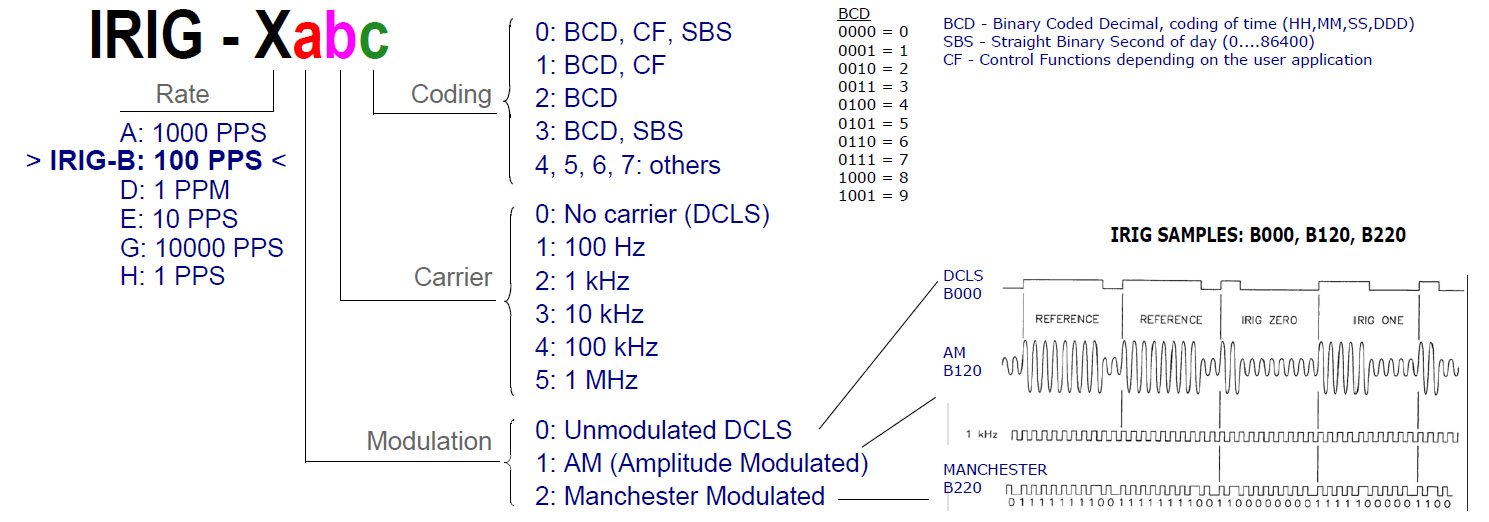About IRIG-B
IRIG-B sends a timing signal every second at 100 pulse/sec rate therefore the 100 is the number of bits of each frame. IRIG-B info includes Year, Day of the year, Hour, Min and Sec.
MIAMI 12.12.22
IRIG-B (or Inter-Range Instrumentation Group-B) is a standard for time and frequency synchronization used in a variety of applications, including synchronizing substations and airports. The length of time that IRIG-B will be used for these purposes depends on several factors, including the specific requirements and needs of the systems being synchronized, as well as any potential advances or improvements in technology that may make other synchronization methods such as PTP more effective or efficient. In general, however, IRIG-B is a widely-used and well-established standard for time and frequency synchronization, and is likely to continue being used for these purposes for the foreseeable future.

Fig 1. IRIG-B structure.
IRIG-B is a standard for time and frequency synchronization that has evolved over time, and there are several different versions of the standard, including optical, electrical, and AM versions. The specific version of IRIG-B used in a given application will depend on the specific requirements and needs of the systems being synchronized, as well as the availability and compatibility of the different versions. For example, the optical version of IRIG-B is often used for long-distance synchronization, while the AM version is commonly used for short-range synchronization. Overall, the various versions of IRIG-B are designed to provide reliable and accurate time and frequency synchronization for a wide range of applications.
Some common examples of industries that use IRIG-B include:
- Aerospace and defense: IRIG-B is often used in aerospace and defense applications to synchronize systems and equipment, such as radar and navigation systems, missile guidance systems, and satellite communication systems.
- Telecommunications: IRIG-B is commonly used in telecommunications systems to synchronize clocks and timing signals, which is essential for ensuring the accurate transmission and reception of data.
- Power and energy: IRIG-B is frequently used in power and energy systems, such as electric power grids, to synchronize substations and other equipment, which is necessary for maintaining the stability and reliability of the power system.
- Transportation: IRIG-B is also commonly used in transportation systems, such as railways and airports, to synchronize clocks and other systems, which is essential for ensuring the smooth and efficient operation of these systems.
Overall, IRIG-B is a widely-used and well-established standard for time and frequency synchronization, and it is used in many different industries and applications where accurate and reliable synchronization is required.
IRIG-B testers
ALBEDO testers such as xGenius and Zeus have features to monitor frequency and time clock signals, including IRIG-B time codes, and runs synchronization tests on them.

Fig 2. IRIG-B-module to test the quality of the signal.
xGenius and Zeus are multi-technology tester to install and maintain networks up to 10 Gb/s. It includes all the features needed in Ethernet optical/electrical transmission and PTP/SyncE synchronization. It also provides full IRIG-B/T1/E1/E0/Datacom support while the C37.94 interface and One-way Delay makes it ideal for Power Utilities.
IRIG-B Network Clock
ALBEDO also manufacturers clocks that support IRIG-B interfaces. One of the models is Net.Time Ω allows for multiple configurations to meet the timing demands of any industry, including data centres, stock exchange, broadcast, IoT, power utilities, or air traffic control. The result is always a reliable and fault-tolerant solution to loss of reference, network outages and power failures. Simultaneously Net.Time Ω simplifies the migration to PTP without abandoning investments in NTP, IRIG-B or BITS, facilitating on this way the integration, interaction and translation of all types of signals, profiles and protocols.


